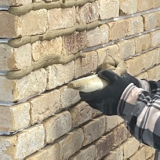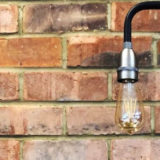Brick Slips, often referred to as brick Veneers, or Brick Tiles are thin cuts of brick that serve as a decorative surface to give the appearance of a genuine brick wall.
Plasterboard, on the other hand, is a lightweight building material made of gypsum, commonly used in interior construction due to its ease of installation and finishing.
This article explores whether brick slips can be effectively fixed to plasterboard, covering everything from material choices to installation techniques.
What Are Brick Slips?
Brick slips are exactly what they sound like a slim slices of brick that are used primarily for aesthetic purposes.
They are an excellent choice for interior decorations, offering the rustic charm of brick without the structural bulk and weight.
Their lightweight and versatile nature make them a popular choice among homeowners looking to add a touch of traditional style to their interiors.
Understanding Plasterboard
Plasterboard is essentially a panel made from gypsum plaster pressed between two thick sheets of paper.
It is used for constructing walls and ceilings and is favored for its quick installation and smooth finish which makes it ideal for painting or wallpapering.
However, when it comes to installing heavier decorations like brick slips, there are considerations to keep in mind regarding the strength and preparation of the plasterboard.
Essential Tools and Materials
Before beginning the installation of brick slips on plasterboard, it’s essential to gather the right tools and materials. You will need:
- Brick Slip Rapid Set Tile Adhesive suitable for both plasterboard and brick slips
- Notched trowel
- Measuring tape
- Tile spacers
- Lime Mortar (Grout)
- Sealant
Preparing the Plasterboard Surface
Preparation of the plasterboard is crucial for a successful installation. The surface should be clean, dry, and free of any debris or dust.
It’s also important to check that the wall is structurally sound and can support the weight of the brick slips, especially if they are being installed in a larger area.
Choosing the Right Adhesive
Selecting the correct adhesive is vital for ensuring that the brick slips adhere properly without risking damage to the plasterboard. A flexible tile adhesive is often recommended because it can accommodate slight movements within the wall without causing the slips to come loose.
We recommend our Brick Slip Tile Adhesive for all installations of our brick slips, it’s been tried and tested by ten’s of thousands of installers nation wide and ultimately is the perfect match for our products.
The Installation Process
Installing brick slips on plasterboard involves a few detailed steps:
- Apply adhesive using a notched trowel evenly over the plasterboard.
- Press the brick slips firmly into place, using spacers to maintain even gaps.
- Allow the adhesive to set according to the manufacturer’s instructions before removing the spacers and applying grout.
Cutting and Fitting Brick Slips
Cutting brick slips to fit around corners and edges can be done using a wet saw or an angle grinder equipped with a diamond-tipped blade.
It’s important to measure and mark your cuts carefully to ensure a clean, straight edge.
Finishing Touches
Once the brick slips are installed and the adhesive has cured, the next step is to apply grout in the joints.
This not only enhances the appearance of the brick wall but also helps to secure the slips in place. After grouting, applying a sealant will help protect the surface from moisture and dirt.
Brick Slip Maintenance and Upkeep
Maintaining brick slips is relatively straightforward. Regular dusting and occasional washing with a mild detergent are usually sufficient to keep them looking their best.
For any damaged slips, it is often possible to remove and replace individual pieces without disturbing the entire wall.

(Amazon HQ in London – Case Study)
Pros and Cons of Installing Brick Slips on Plasterboard
While installing brick slips on plasterboard can add significant aesthetic value to a room, there are pros and cons to consider. On the plus side, this method allows for relatively quick and easy renovation without the need for extensive demolition or construction.
However, the longevity and durability of the installation can be a concern if not done correctly, particularly in terms of the adhesive and the weight capacity of the plasterboard.
Conclusion of brick slips on plasterboard walls
Fixing brick slips to plasterboard is a viable option for those looking to incorporate the aesthetic of brick into their home without the structural requirements of traditional masonry. With the right preparation, materials, and installation techniques, this method can provide a durable and attractive result.
Brick Slip FAQs
- Can brick slips be used in bathrooms?
Yes, but they should be properly sealed to protect against moisture. See our Brick Slip Sealer for this application. - How long do brick slips last on plasterboard?
With proper installation and maintenance, brick slips can last a lifetime without issue, Just the same as any Kitchen or Bathroom tile. - Are brick slips suitable for exterior use?
Absolutely, they can be used outdoors, it is important to choose slips that are rated for exterior use and to ensure they are properly sealed against weather conditions, if unsure just contact us direct. - Can I install brick slips myself?
Yes, DIY installation is possible with the right tools and careful planning. Check out our DIY section of our website here! - How do I remove older brick slips that I want to update?
Removing brick slips can be challenging and may require cutting them out, potentially damaging the plasterboard underneath. The removal method is the same as any other tile removal method.





































